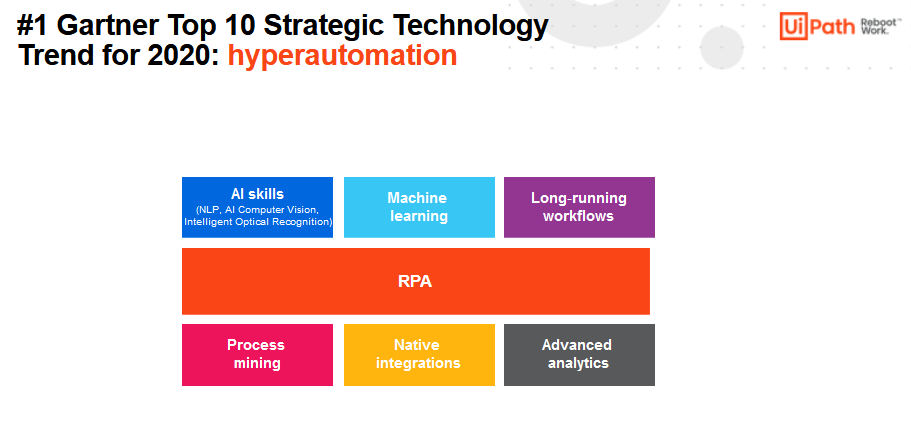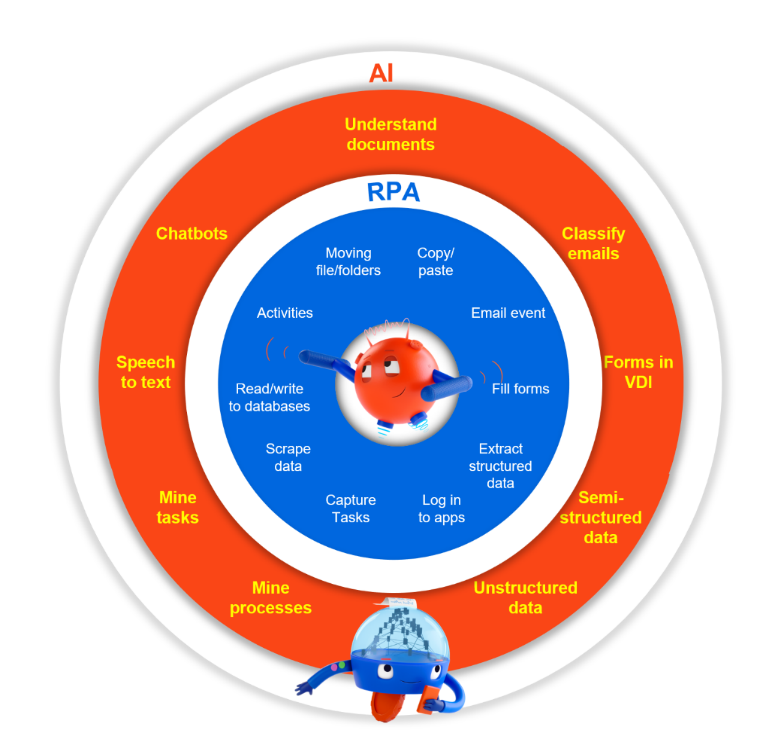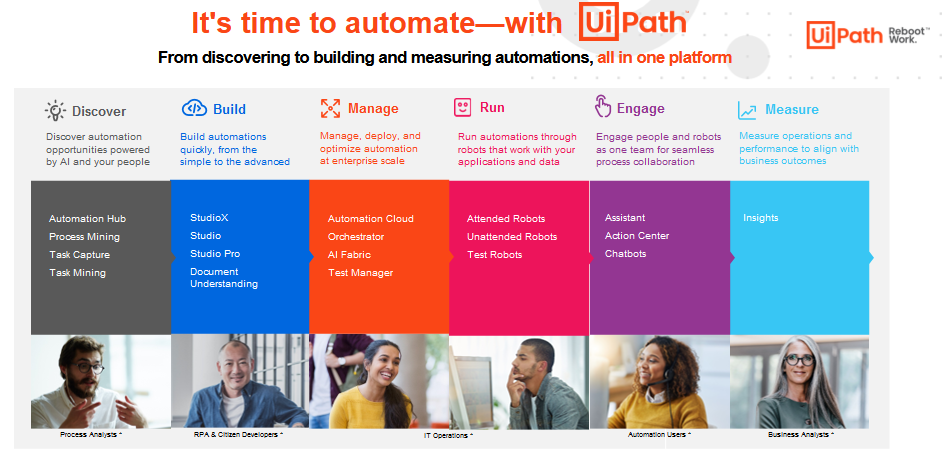Prabhdeep (PD) Singh is the head of AI products at UiPath
Robotic Process Automation (RPA) and artificial intelligence (AI) have garnered a lot of hype in recent years for their ability to drive never-before-seen productivity, efficiency, and customer satisfaction gains.
In fact, the global RPA market is expected to reach $10.7 billion by 2027, and the AI market is forecast to reach a monumental $390.9 billion by 2025. But despite how many conversations these new technologies have sparked recently, there’s still a lot of confusion over what differentiates them, what each is uniquely good at, and how they are increasingly able to work in tandem.
Modern enterprises are made up of both simple processes and those rich in complex decision making and, as such, need complementary technologies to handle the full range of their workflows. On one side of the spectrum lies RPA, which thrives in systems that have a clear, step-by-step flow. On the other side sits AI, which can augment and improve human decision making in complex processes.
Together, RPA and AI play an important role in driving operational efficiency and an important role in helping transform how your company does work.
First, what is RPA?
RPA is a core automation technology that acts as the backbone to software robots that can interact with digital systems to relieve humans of repetitive, time-consuming, and non-value-added work. Basically, RPA can take the work you hate off your plate.
RPA works best when it’s used to handle rule-based processes where the workflows don’t change over time or require a high rate of human intervention for exemption handling. By itself, RPA can adeptly handle some of the most common, and time consuming, processes that support your business, such as:
- Logging into applications
- Connecting to system APIs
- Copying and pasting data
- Extracting and processing structured content from documents
- Opening emails and attachments
- Scraping data from the web
As the foundation of hyperautomation—the number one strategic technology trend for 2020 according to the Smarter with Gartner Gartner Top 10 Strategic Technology Trends for 2020 report—RPA paves the way for future tools technologies like AI, machine learning, and process mining.

By implementing RPA from the beginning, companies build the automation scaffolding they’ll need to support the full ecosystem of automation tools down the line.
What is AI and how does it differ from RPA?
“The potential of automation is vast. We believe the power of AI can make it almost limitless. And so, we’ve built AI into every part of the UiPath platform. You can reach new levels of productivity and automate more.”
–Daniel Dines, co-founder and CEO, UiPath
Simply put, AI is a complementary sibling to the RPA robots we’ve come to love. RPA and AI work in tandem to expand automation into all sorts of new areas allowing you to automate more and complex tasks.

AI can easily handle complex processes that previously were could only be done by humans alone. This is because AI robots can make cognitive decisions using large data sets to predict several possible outcomes.
AI can go beyond ‘execution’ to ‘thinking,’ for example:
- Understanding documents
- Visualizing screens (including virtual desktops)
- Comprehending conversations
- Discovering tasks and processes to automate
- Processing language
- Handling semi-structured or unstructured data
For years, AI was a concept relegated to the land of science fiction—something companies and industry leaders were promised as a far-off dream to revolutionize, at some later date, the work they did.
But not anymore.
To clarify, I’m not talking about physical robots that utilize AI. And I’m not talking about artificial general intelligence (AGI)—the kind that Elon Musk says is going to take over the world. Instead, I’m talking about practical AI that builds machine learning models for more efficient business and enhances the human experience, not replaces it. This kind of automation is the most practical application of AI in the workplace.
However, to succeed, companies must embrace both RPA and AI as partners.
AI and RPA: It takes two to tango
As in life and tango, it takes two. In the world of automation strategy, it takes both AI and RPA working together to drive operational enterprise efficiencies. These two partner technologies work together to cut process fat and make human lives easier by streamlining their own halves of enterprise operations.
I see this in nearly every industry on earth. Take, for example, differential diagnosis processes in hospitals that aim to diagnose the 2019 novel coronavirus (COVID-19).
Using RPA, hospitals can build software robots that look at a set of COVID-19 symptoms, such as a high fever and body aches, and alert medical professionals to new cases. But RPA is limited to the initial “yes or no” style intake questions and can’t adequately assess more complex criteria (of which there are many in healthcare settings).
But RPA can consolidate this baseline patient data for more advanced, predictive process analysis by AI.
Hospitals can complete an initial screening of patients with RPA, and then use AI to interpret x-rays. UiPath AI Computer Vision can be used to detect indicators of COVID-19-related pneumonia in patients and make treatment recommendations.
Beyond COVID-19, AI can be us used to determine clinical outcomes like accurately identifying low birth-weight pregnancies and reduce time-to-treatment.
Outside of the healthcare arena, AI-enabled automation can help a myriad of other industries drive operational efficiency gains, employee and customer satisfaction, and improved compliance. One such example we’ve seen lately has been the application of AI in the insurance industry to help predict claim fraud using machine learning and UiPath AI Fabric.
Using these tools, the company was able to integrate data in siloed data sources to predict whether parts of a claim were fraudulent and flag and prioritize their processing accordingly.
By combining RPA and AI in practice, enterprises increase their capabilities and make their processes more efficient.
When to roll out RPA and when to send in AI
There’s a good rule of thumb to help you figure out if a process should be handled by RPA or AI: start your automation journey by first tackling those processes that you can easily build a map of mentally and then add AI to workflows deemed too complex for RPA alone. This not only gives you and your robotic Center of Excellence (CoE) quick wins early in your transformation but also builds an automation foundation that you can later scale with AI.
RPA cleans up your underlying processes to provide an easily integrated framework on top of your existing digital systems. Without this underlying foundation, the barrier to entry for integrating AI is much higher. Without that foundation, AI would need to be manually woven into your core processes.
There is an exception to this approach that’s worth noting: If you’ve already heavily invested in business process automation in the past—meaning you’ve already done the work to ensure process hygiene—you can look at opportunities for AI and RPA in tandem.
Regardless, after you’ve selected and automated your first layer of simple processes, it’s time to look at those workflows deemed “too complex” for RPA alone. These will be your candidates for AI, and should include:
- Workflows where the outcome cannot be predicted 100% of the time (such as processes that support property valuation, loan defaults, and inventory forecasts)
- Highly variable processes that do not depend on a clear-cut set of rules (such as resume matching, purchase decisions, and language translation)
- Processes that rely on unstructured data from documents, articles, images, videos, and emails (such as invoice extraction, email routing, and speech to text)
Recommended reading: AI Just Got Easier: UiPath Starter Models to Automate More Complex Processes
In the real world, these AI-supported processes can look like:
- Readmission prediction in healthcare
- Pricing optimization in retail
- Fraud detection in financial services
- Deal guidance in process services
And those are just a few examples.
Additionally, as you automate more and more of your operations, you’ll notice bottlenecks where higher-level judgment is needed to move through a workflow. These are more opportunities for AI. What’s more – you don’t need data science skills to get started with AI.
Here’s a summary I’ve shared with customers: We’ve sown a lot of seeds and all the forest that is going to grow on top of it is this forest of self-improving enterprise applications.
These technologies are revolutionary, and we’re excited to be uniquely positioned to support a new future of business where companies can achieve optimal, automation-enabled business that drives return on investment (ROI) like never before.
The importance of an enterprise platform with both AI and RPA
As much as we love RPA, there’s a ceiling on how efficient you can be when you limit yourself to flowchart-friendly process automation.
On the flip side, if you only integrate AI, you lack the infrastructure and lifecycle support to scale and face slow integration and scaling.
That’s why choosing a vendor that offers both—like UiPath—helps you overcome gaps between departments, processes, and verticals and take advantage of the scaffolding of RPA when rolling out AI capabilities.
We make the integration of AI and RPA painless by handling integration for you and building on the RPA capabilities already native to our Platform.
While other companies work only with the underlying data layer and don’t support the full duplex of communication between front-end apps, the UiPath Platform lets you seamlessly drop in machine learning models using the underlying foundation of RPA.

This allows you to easily implement and fully realize the ROI of AI and RPA without hiring a whole data science practice to support it. And, if you already have some in-house data science capabilities, we can make those teams more efficient.
To learn more about how AI and RPA combine to transform modern enterprises, enjoy our on-demand webinar AI-Enhanced Automations – Combining Transformative Capabilities.
[ad_2]
Source link



